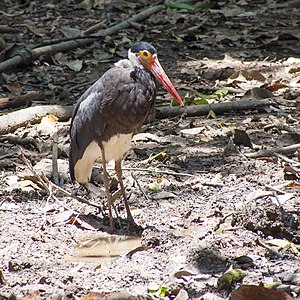Hump stork
| Hump stork | ||||||||||
|---|---|---|---|---|---|---|---|---|---|---|

Hump stork ( Ciconia stormi ) |
||||||||||
| Systematics | ||||||||||
|
||||||||||
| Scientific name | ||||||||||
| Ciconia stormi | ||||||||||
| ( Blasius , 1896) |
The hump stork ( Ciconia stormi , syn .: Melanopelargus episcopus stormi ) is the rarest stork species in the world with 250 to 500 individuals. According to the IUCN, the bird's populations are endangered.
features
The 75 to 91 cm long humpback stork has black and white plumage, a red beak and a featherless, orange facial skin with yellow circles under the eyes. The plumage of young birds and that of adult birds outside of the breeding season is simpler.
Occurrence
The humpback stork occurs disjointly on Borneo , Sumatra , the Mentawai Islands , in southern Thailand , western Malaysia and Brunei . It lives in freshwater biotopes undisturbed by human influence with adjacent lowland forest and on rivers with floodplains.
behavior
The humpback stork lives alone but is sometimes seen in small groups. It feeds mainly on fish, and probably also on amphibians, small reptiles and insects. The reproductive behavior is little known. So far only two nests have been observed, one from April to June in Sumatra, the other with hatched young birds in mid-October in Thailand. The bird builds its nests on trees and nests on its own. The nests consist mainly of twigs, have a diameter of half a meter and are about 15 cm high. Cusp storks lay two eggs. The young birds have white down plumage and are able to fly after 45 days.
literature
- Josep del Hoyo et al .: Handbook of the Birds of the World. Volume 1: Ostrich to Ducks. Lynx Edicions, 1992, ISBN 84-87334-10-5 .
Web links
- Videos, photos and sound recordings of Ciconia stormi in the Internet Bird Collection
- Ciconia stormi in the endangered Red List species the IUCN 2008. Posted by: BirdLife International, 2008. Accessed November 24 of 2009.
- http://magazin.naturspot.de/text/hoeckerstorch.html